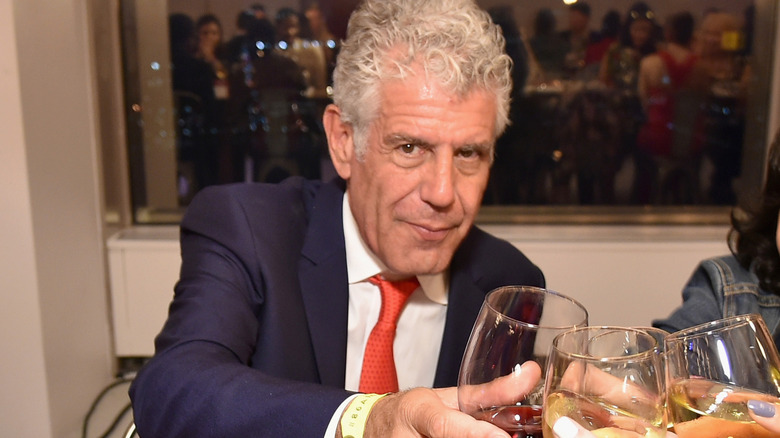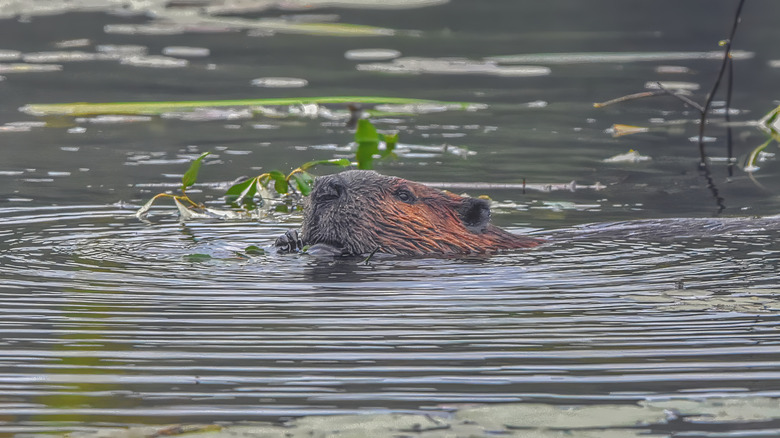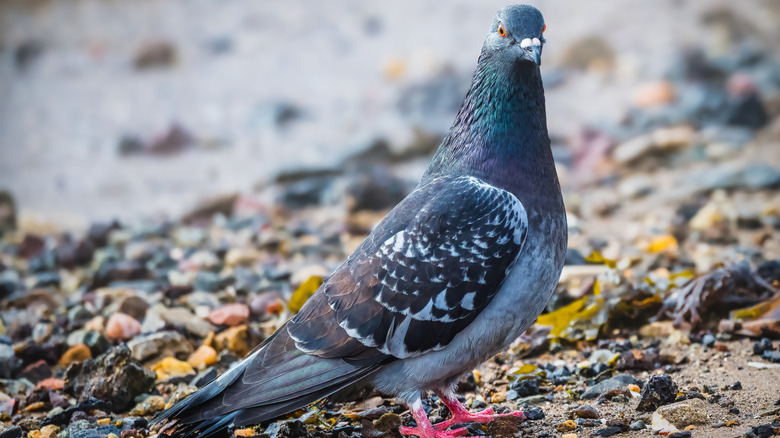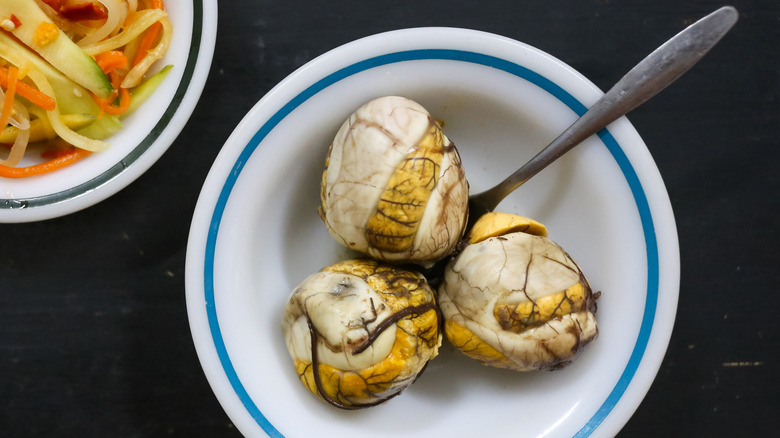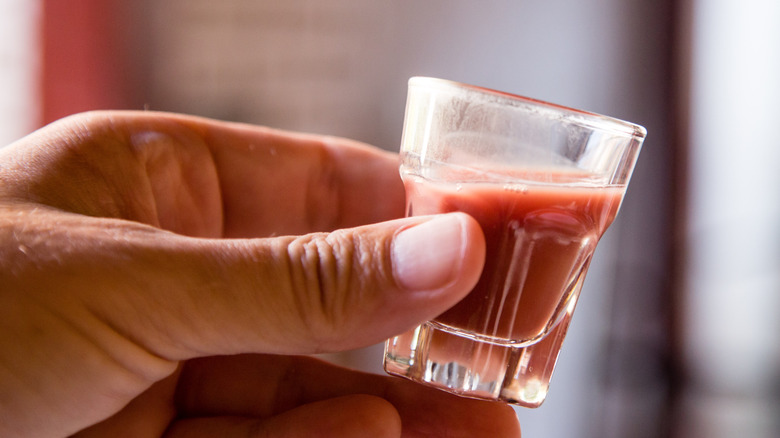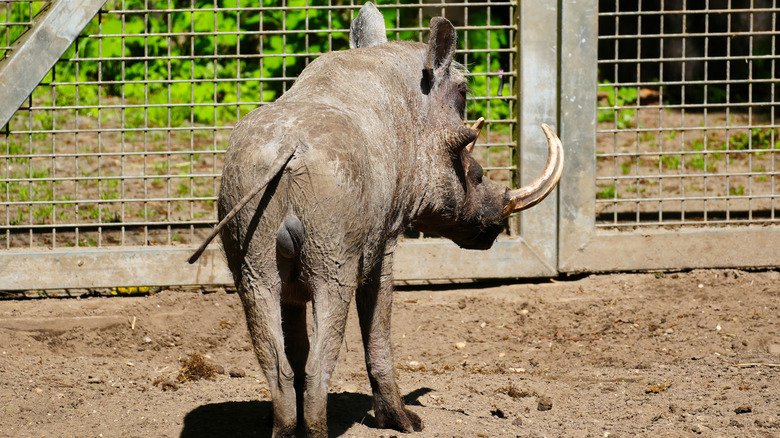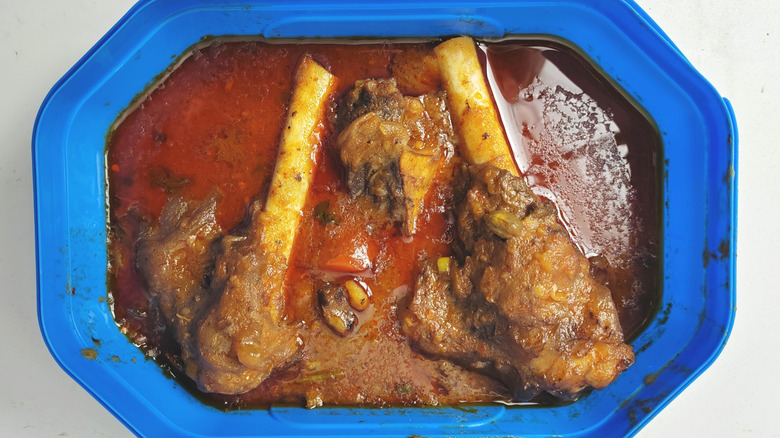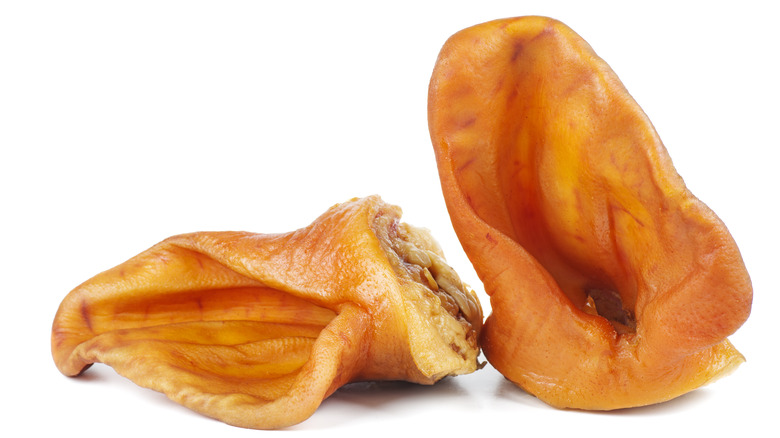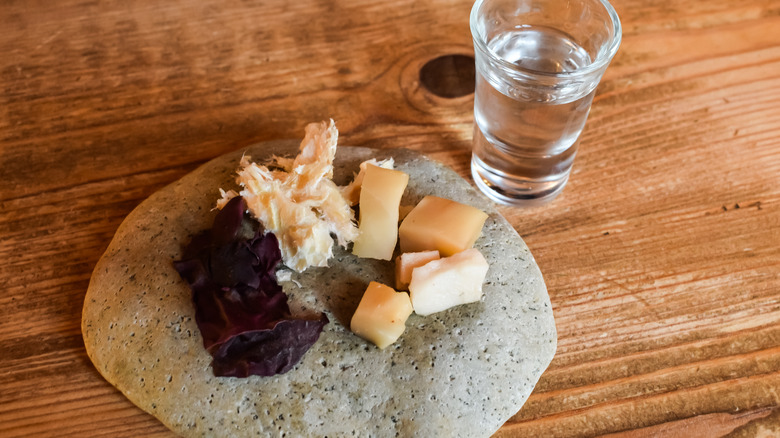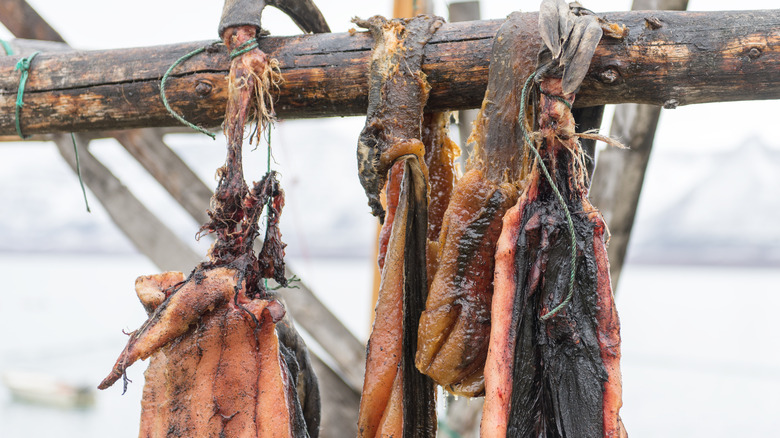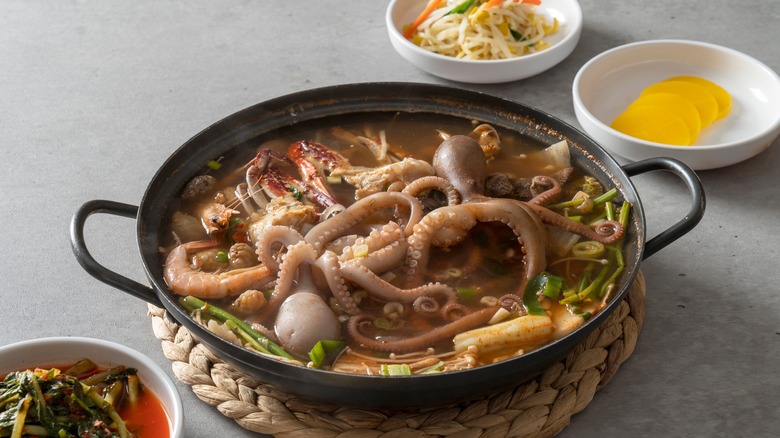The Most Outrageous Things Anthony Bourdain Ever Ate
Anthony Bourdain was never just another celebrity or TV host who liked cooking and eating. He was an explorer, a discoverer, and an extremely sharp visionary. In an industry that often glosses over the truth in favor of shiny, palatable storytelling, his voice promised honesty, regardless of the topic at hand.
Throughout his globe-trotting career, Bourdain sought out dishes that most people wouldn't dare think of eating. From fermented shark in Iceland to beaver stew in Quebec, he approached each meal with equal parts respect, curiosity, and an inimitable dry sense of humor. For him, sharing a meal wasn't just about ingredients cooked in a particular way. Rather, each meal was a story with a history and a deep cultural connection. In celebrating the boldest meals braved by Bourdain, we get a glimpse of what made him such a fearless cultural ambassador and collectively mourn the loss of a man who was willing to taste the world exactly as it is.
Anthony Bourdain tried beaver in Quebec
In Season 1, Episode 4 of "Parts Unknown," Anthony Bourdain talks shop with chef Martin Picard, one of Montreal's most popular chefs. Picard's philosophy is that if you trap beavers, you should cook them and eat them, not just strip them of their pelts.
Eating beaver may seem pretty outrageous, but in Bourdain's experience, eating beaver meat that was well-cooked in its blood and juices left a lasting impression. Of course, his beaver meat was cooked by a master, with the gravy looking thick, almost like chocolate. Picard prefers it this way, and the result, as described by Bourdain, was absolutely delicious. The beaver tail, however, was another story, and you may want to give that a miss.
While it might seem too out-of-the-box for some, those who like game meat will enjoy beaver as it has a unique taste of its own. While it may not compare with some of the other dishes on this list in terms of outrageousness, it definitely still isn't for the squeamish.
Pigeon impressed Anthony Bourdain in Cairo
Many people would be repelled by the idea of eating what are often considered rats with wings. But as knowledgeable chefs know, pigeon is considered a delicacy in Egypt and many other parts of the world. In Season 4, Episode 18, of "No Reservations," Anthony Bourdain was fortunate enough to try stuffed pigeons prepared by the hands of experts in Cairo, where pigeons are often consumed for their rumored aphrodisiacal properties.
The pigeon Bourdain ate was stuffed with rice seasoned with cinnamon, cardamom, and bay leaf, then simmered in stock, covered in spices, and seared until caramelized. It was then served with tahini, a side salad, and a glass of pigeon soup. Bourdain was impressed by both elements of the meal, lamenting the fact that the U.S. no longer considers the bird a delicacy and joking that the next time a pigeon hits your windshield, you may want to consider making a meal of it.
Anthony Bourdain revealed his thoughts on balut on live television
One of the more extraordinary things that Anthony Bourdain tried during his television career was balut, having been challenged to do so by Piers Morgan. Balut is a developing bird embryo, typically a duck, and is a delicacy in the likes of the Philippines, Cambodia, and Vietnam. One probable reason for its popularity is the theory that it has the ability to increase fertility, which is debatable. In particular, it's believed in Vietnam that it enhances virility in men.
Crack the shell, and balut emits a clear but flavorful broth. Many people just drink this bit of the hard-boiled duck fetus and chuck the rest, but others go the whole hog and eat the fetus. While some prefer to eat it a bit at a time, others wolf it down in a bite or two. The fetus, remember, is partially formed, but the texture is surprisingly soft and mousse-like. Bourdain had no problem with the taste, only with the texture. If you can get past the mental image of eating a whole duckling and you boast an adventurous palate, then this is something you might want to try.
Anthony Bourdain sampled several parts of a cobra in Vietnam
This one is not for the faint of heart but will appeal to those who are unabashedly carnivorous. It is the still-beating heart of a cobra, something Anthony Bourdain tried on one of his many trips to Vietnam, in a place called Nhà Hàng Huong Rung.
A live cobra was cut open, and its heart was removed and served in a bowl in Season 1, Episode 3 of "A Cook's Tour." Bourdain wolfs the whole heart (which was notably quite small) down, still beating and bloody. According to him, it was still warm and continued to beat the whole way down. Once that part was over, the cobra was turned into a five-course meal. As stated in the episode, cobra heart is supposed to make you strong, but the blood is said to be even more potent, hence why it's also consumed. Whether or not that's true is up for debate, but at least the cobra heart and blood impressed Bourdain more than the tripe.
Anthony Bourdain was unimpressed by warthog anus in Namibia
Conan O'Brien's reaction to Anthony Bourdain's culinary encounter with a warthog anus says it all. In an episode of "Late Night with Conan O'Brien," the presenter struggles to wrap his head around Bourdain trying the dish, repeatedly asking why he would choose to do so. The answer to that question lies in the context of the encounter. While filming "No Reservations," Bourdain was in the presence of the chief of a Namibian tribe, who presented him with what is supposedly the best part of a freshly killed warthog: the anus. He ate it out of respect for the local culture.
The anus is prized amongst the local tribes for its high fat content. The organ was first cleaned by squeezing out its contents, then grilled for a very short time over an open fire. This lightly charred meat was then presented to Bourdain, who simply claimed that it was chewy. With his characteristic sense of humor, Bourdain later declared the meat to be the worst meal of his life, but we liken the experience to earning him a medal for cultural curiosity.
In Singapore, Anthony Bourdain tried bone marrow soup
In Season 4, Episode 1 of "No Reservations," Bourdain returns to Singapore. Throughout his TV career, he visited this island city-state four times and wrote in his field notes on the Parts Unknown blog that it was "possibly the most food-centric place on Earth, with the most enthusiastic diners, the most varied and abundant, affordable dishes — available for cheap — on a per-square-mile basis." As he navigates the winding hawker center saturated end to end with delicious food, he sits down for "a sticky, slippery yet utterly wonderful heap of sauce-dripping bones" (via Today Online).
Sup tulang, or bone marrow soup, isn't your standard soup. Instead of a broth, it consists of a mound of large mutton bones drenched in a bright red sauce. As the veritable "ang moh," a term used to indicate a foreigner to locals, he made headway gnawing into the bones stewed in the sweet chili tomato sauce. But getting to the best part, the bone marrow, was another story. As he tapped, banged, and splattered, a sympathetic vendor stepped in and handed him a straw. It worked. As he later wrote in The New York Times, "I jammed it in and sucked, striking the good stuff immediately. I came away with red-stained fingers, a ruined shirt, and a feeling of happy, somewhat guilty stickiness."
A pig ear sandwich was on the menu for Anthony Bourdain in the Mississippi
While Anthony Bourdain famously traveled the world in search of culinary secrets, he seemed to spend more time abroad than he did exploring America. However, he still delved into several pockets of the nation's culinary history, including in Season 3, Episode 6, of "Parts Unknown," where he visited Jackson, Mississippi. At the city's Big Apple Inn – a nearly century-old eatery on Farish Street, one of the last remaining Black-owned businesses in the area – Bourdain tasted history between two buns. The dish in question? A deceptively simple-looking concoction consisting of a soft bun, heapings of mustard and homemade hot sauce (after all, hot sauce does make everything better), crunchy slaw, and juicy pig ears.
This is a Southern classic with deep roots in history. Once a necessity for those who had little and made do with butcher scraps, the pig ear sandwich became a symbol of resourcefulness and cultural pride. For Bourdain — who famously had a soft spot for dishes that told stories, such as the bánh mì in Vietnam and the po' boy in New Orleans — this sandwich earned a spot in the same revered category.
Anthony Bourdain didn't enjoy fermented shark in Iceland
Gordon Ramsay was once left unimpressed by hákarl, and Anthony Bourdain had a similar reaction. The chef described it "the single worst, most disgusting and terrible tasting thing" he'd ever eaten (via The Wall Street Journal). In Season 1, Episode 2 of "No Reservations," Bourdain got to try Iceland's infamous fermented shark. He was served this Arctic predator (albeit chopped into cubes) at Múlakaffi in Reykjavík. It's here that he celebrated Thorrablot, the Icelandic midwinter festival.
Early Icelanders used Viking-era preservation methods and would prepare the dish by beheading and then burying the Greenland shark in sand. The fresh meat is considered toxic due to the high levels of trimethylamine oxide, so, in order to expel all the nasty fluids, the animal is left to ferment for weeks. Stones press on the carcass and help it dry out further. The shark meat is then exhumed and hung out to dry until it develops its signature ammonia-rich (yes, urine-smelling) aroma and leathery texture.
While Bourdain's response to this Icelandic delicacy may have been a result of his struggles to keep it down and is shared by many others, the local popularity of hákarl endures. Admittedly, it's not for everyone. Many reach for brennivín, a potent caraway-spiced spirit to wash it down. But for many Icelanders, hákarl is not about flavor but more about history. Whether approached with curiosity, aversion, or interest, hákarl is sure to leave an impression.
Trying raw seal surprised Anthony Bourdain
In Season 2, Episode 4 of "No Reservations," you're instantly pulled into one of Anthony Bourdain's most powerful moments on screen. From hunting the seal to sitting on the family kitchen floor and partaking of the feast, his respect for a culture far removed from his own never wavered. As each family member dug into various parts of the seal, Tony observed without judgment. Traditionally, no part of the bounty is wasted after seal-hunting. The blood is collected and used in stews and soups, and the blubber is used to make treats later.
As the guest, Tony was offered the best bits, including the liver, a whisker treat (which he likened to a sea urchin), and the greatest prize of all, the eyeball. None of this was cooked, but instead enjoyed raw. As per Bourdain, the eyeball was slit open and sucked like a Concord grape. "This is an act of pure generosity and kindness to an honored guest," he said, expressing his gratitude (via YouTube). Years later, Bourdain went on to criticize a boycott of Canadian seafood over the traditional seal hunt, claiming that a ban would negatively impact the nation's indigenous communities.
Anthony Bourdain ate live octopus in South Korea
In 2006, Anthony Bourdain visited Seoul, Korea, for Season 2, Episode 11 of "No Reservations." Along with an assistant on the show, Nari, he tore through the city, visiting everything from street food stalls to a kimchi-making session along the way. One of the episode's most unforgettable moments was his casual snack of live octopus. While winding his way around the city's main fish market, Noryangjin, Bourdain was offered a plate of chopped but still live octopus. A far cry from the tender meat of cooked octopus, the tentacles continued to wiggle around. Bourdain expertly dipped one moving limb into some chili paste before popping it into his mouth, pausing only to dislodge the suckers from his cheek.
But that wasn't his only encounter with the dish. Bourdain, along with chef David Chang, later tracked down the delicacy at a restaurant called Sik Gaek Chun Ha in Koreatown. While it remains a revered dish in South Korea and Japan, eating live octopus can be dangerous, even fatal, if the proper precautions are not taken. The suckers need to be cut up into small pieces before they're consumed.
